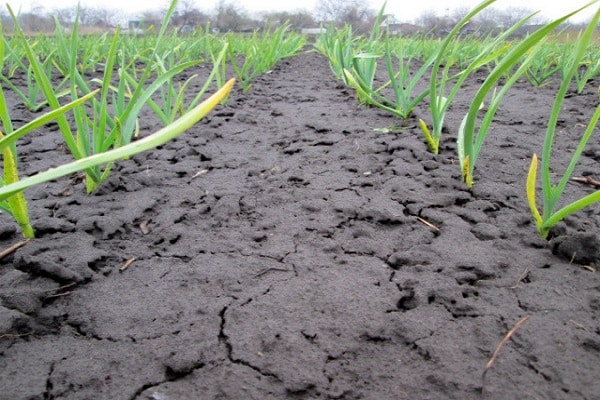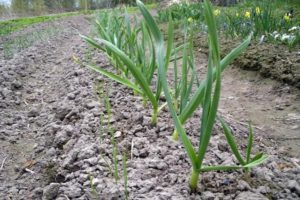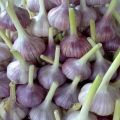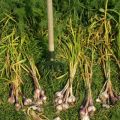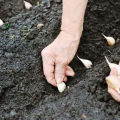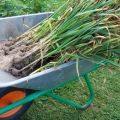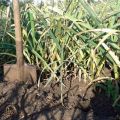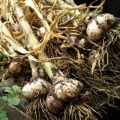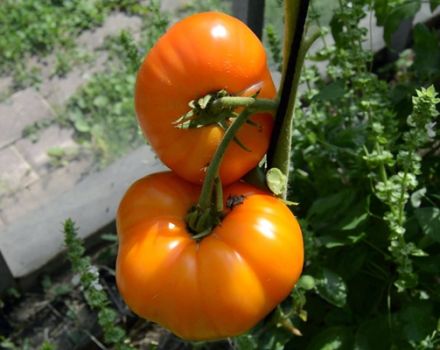Technology for growing and caring for winter garlic in the open field
Garlic culture is demanding on growing conditions. How to grow large winter garlic in a personal plot, how to protect plantings in winter, how to feed, what is the irrigation regime. The answers to these questions lie in the biological characteristics of the plant.
Winter garlic - biological features
The culture adapts well to climatic conditions, is winter-hardy, tolerates low temperatures well. Root germination in winter varieties occurs at 0 degrees, and as the temperature rises to 3-5 degrees, their intensive growth begins. The plant requires moisture in the periods immediately after planting and in the spring, when active new leaf formation begins. Growing winter garlic in the open field allows the plant to form a sufficient root mass in the fall and make the most of the soil moisture reserves in early spring.
The shallow root system of the plant is very demanding on soil fertility, and is located at a depth of 10–20 cm. This must be taken into account when preparing the beds. Light, well-fertilized, slightly acidic soils are suitable for the culture. To get a good harvest, it is necessary to create conditions under which winter garlic has time to take root before the cold weather begins. Wintering and the intensity of growth with the onset of spring depend on the formation of a plant in the autumn.
How to grow a good harvest of garlic?
The needs of the plant form a list of works to be carried out in autumn, spring and summer. The extended growth period affects the planting rules. It is necessary to provide for the protection of plants in winter, to support young shoots with additional fertilizing in the spring. How to get high-quality bulbs of a valuable vegetable crop in open field conditions.

After harvesting winter garlic select high-quality bulbs for autumn planting. And they begin to prepare the ridges at the end of August. According to the technology of growing winter garlic, in the fall you need to select and prepare a site for planting, plant the crop on time and provide plants with protection in the winter.
Choosing a site
When planting winter garlic, it should be borne in mind that the plant is demanding on illumination, it dries up with too long waterlogging. Therefore, the area for the ridge with bulbs should be open and located on an elevation in order to avoid flooding with melt and rainwater.
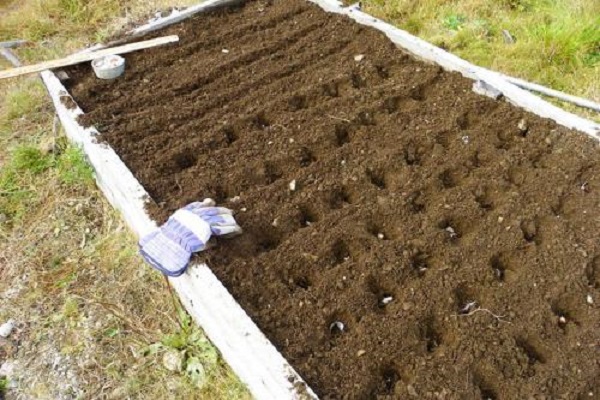
Agricultural technology for growing winter garlic requires mandatory compliance with crop rotation. The precursors for the plant can be vegetables with an early harvest. It is best to plant plants after legumes, pumpkin seeds, early cabbage varieties, spicy greens.
It is necessary to grow a culture on highly fertile sandy loam or loam. Sowing beds are prepared in a month, brought in for digging for every 1 m2 half a bucket of humus, 15–20 g of potassium salt and 30 g of superphosphate. With high acidity, the soil is deoxidized in advance by adding 250-300 g of lime. Fresh organic matter is not added to the culture. They dig the earth to a depth of 18–20 cm, level it and keep it clean. Before planting, the beds are watered abundantly with water.
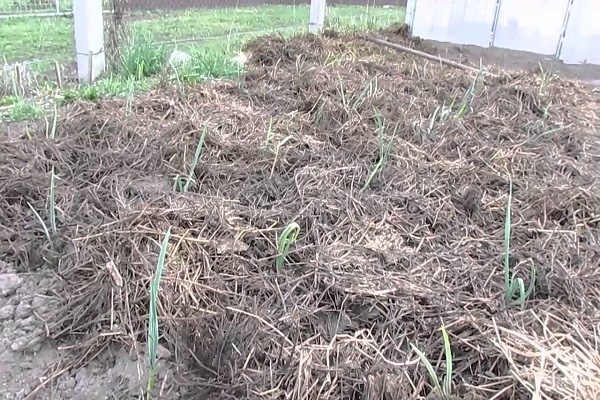
Important! Compliance with planting dates and timely harvesting is the key to a good harvest of winter varieties of garlic.
Timing
A good harvest of garlic depends on the timeliness of planting. Depending on the climatic characteristics of the region, the planting dates vary. In areas with a warm climate (Central Asia, Kazakhstan) where plants are able to winter with leaves, garlic is planted in September. In central Russia, garlic is planted in early October, so that it has time to take root, but does not germinate. In the south of the country, these dates move to the end of October. The planting date is calculated so that 40–45 days remain before the winter cold and the cloves of garlic can grow 10–15 cm long roots.

Planting garlic
For 2-3 weeks before planting, the selected bulbs are kept for 2-3 weeks at a temperature of 3-5 degrees. A couple of days before planting, the heads are divided into slices. In winter varieties, the cloves are aligned in size and generally do not require calibration. Large, good garlic is obtained from cloves with a diameter of at least 10 mm.
We plant a crop by the line method, at the rate of 15 large cloves or 20 average size per linear meter with a distance between the lines of 30–40 cm. It is advisable to deepen the cloves to a depth of 10–12 cm. Additionally, mulching of garlic is used in autumn so that the plants are guaranteed to overwinter. Peat and humus are used, which are poured into a layer of 1.5–2 cm. Such mulch, with the onset of the first spring heat, contributes to the rapid heating of the soil, protects it from crust formation, and retains moisture. What to do in areas with unstable snow cover. The question is not idle. It is customary to accumulate snow in the planting area to prevent freezing and retain moisture.
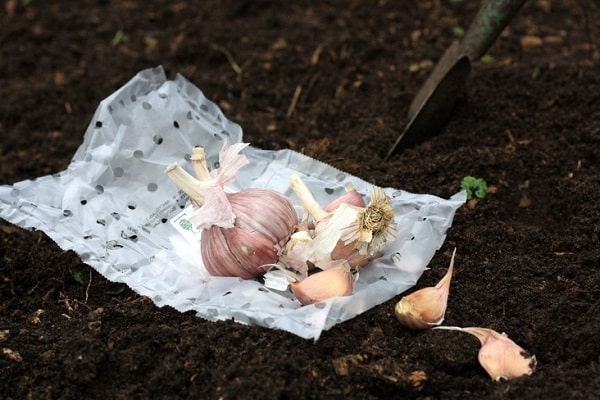
Features of care in the summer
In early spring, when the temperature rises to 6-8 degrees, the first shoots appear. When the danger of frost has passed, we open the ridges, if additional shelter was installed on them. Usually, leaf germination begins at the end of April. Planting care consists of maintaining soil moisture, loosening row spacings, dressing, timely removal of peduncles. Caring for winter garlic in the warm season means watering in the absence of rain, top dressing, obligatory weeding with loosening of row spacings, removing flower stalks, and strict adherence to harvesting dates.

Watering
The culture is demanding on moisture at certain stages of the growing season. The plant needs water immediately after planting and in the early spring period.. Outdoor maintenance is made easier by the high soil moisture in fall and early spring.
- A month after germination, active leaf formation occurs for three weeks. During this period, watering the garlic is carried out every 4–5 days.
- The second stage begins 60–65 days after germination and is associated with the onset of clove growth and the appearance of arrows. In the absence of rain, irrigation is carried out every 2-3 days. If the summer is rainy, then there is no need to water the plants.
- Watering should be stopped a couple of weeks before the planned harvest. Dry soil and dry air accelerate the ripening of the bulbs. Massive yellowing of the leaves will tell you when to stop watering.
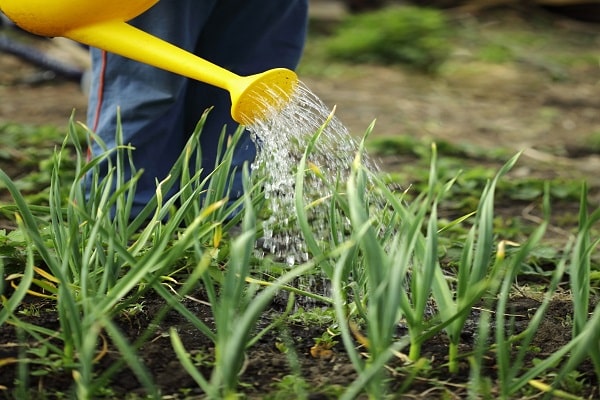
Often, when the tops of a plant turn yellow, what happens is associated with a lack of moisture. Test one of the plants before starting heavy watering. Perhaps the feather turns yellow due to the appearance of pests or decay of the roots.
Top dressing
Cultivation and care without fail imply fertilizing during periods of active formation of leaves and bulbs. As fertilizers for winter garlic, complex dressings with the content of potassium, phosphorus, nitrogen are used. Top dressing with manure and other organic matter attract pests. Therefore, before feeding the plants, stock up on wood ash, which is poured into the aisles for protection.
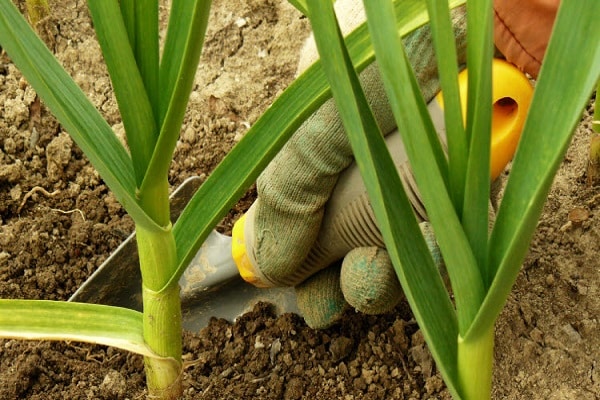
The first feeding of winter garlic is aimed at increasing plant nutrition during the period of intensive leaf growth with the onset of spring warming. Top dressing is carried out with ammonium nitrate, spending 10-15 g per sq. square meter.
At the next stage, the growth of the bulbs is supported by feeding the plants with nitrogen-potassium fertilizers in mid-June.
The latter is carried out with the appearance of the seventh leaf. 10 g of potassium chloride and 20 g of superphosphate are used per meter of planting. Garlic fed in this way is able to store longer, forms larger bulbs.

Attention! Timely removal of arrows from garlic increases productivity by 40%.
Additional care techniques
Caring for winter varieties of garlic in summer differs only in terms of time, in comparison with spring varieties. But it is precisely the timeliness of some types of work that is important for the cultivated crop. An example is the removal of arrows in winter varieties. If you miss the moment, the culture will begin to shoot massively, then you will have to say goodbye to a large harvest.
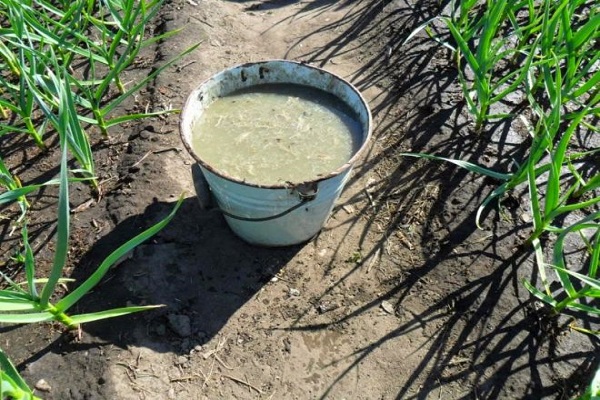
- To increase the yield in winter varieties, it is necessary to remove the peduncle in time. He takes up a large share of the food. What to do if you want to collect valuable seed material, but it's a pity to lose your harvest. You still have to make a choice. Leave a few plants for bulbs. In the rest, the garlic arrow is broken out a week after its appearance. This method allows you to increase the yield by 40-50%.
- As the size of the bulbs grows, they begin to scoop up the soil from it. This helps the smooth growth and intensive formation of the protective scales. Reception does not take long. By caring for the garlic during weeding, you can shovel the soil along the way. Of course, any work requires additional investment of time. But the obligatory procedure of loosening the row spacings can well be combined with raking off the soil from the bulbs.
All the methods of growing garlic are aimed at obtaining a decent harvest. With the harvest approaching in July, you need to be especially careful to correctly assess the degree of ripening. An overgrown bulb falls apart into slices and cannot be stored for a long time.

The garlic is ready for harvesting when the lower feather dries up massively and turns yellow, and the upper level of the leaves begins to lie down. An urgent need to start cleaning. If it is not possible to remove the culture in time, what to do in this case? It is better to pick garlic unripe than to let it overgrow. If the feather at the tips turns yellow, then the process of bulb formation is in full swing. The harvested bulbs will receive nourishment from the leaves after harvest and prepare safely for the dormant period.
